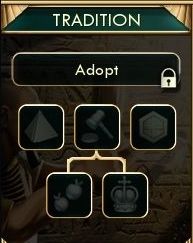Tradition
Food focused three cities approaches
Food focused three cities approaches
Important note: A new patch has slightly nerfed the Tradition tree. For players who don't care to reload to get a fast culture ruin can follow the actual paths in the same orders. Players who want to stick around(regardless to ruins) have to start with a monument first. For these players you will likely have to wait for 3
 before starting a settler.
before starting a settler.Landed Elite and Monarchy can't wait. Ignore the wonder bonus. Go straight for Landed Elite, then Monarchy. Then complete the Tradition tree.
Introduction
The guide outlines the "three cities Tradition" approaches, based on early Granaries and internal food Trade Routes
 . These approaches are for players who want to build an empire based on huge, high population cities. Developing huge cities early provides you many advantages throughout the game. The Tradition social policy tree will provide the fuel necessary for quick growth.
. These approaches are for players who want to build an empire based on huge, high population cities. Developing huge cities early provides you many advantages throughout the game. The Tradition social policy tree will provide the fuel necessary for quick growth.
The Tradition tree
- Key Concept - "Tall v. Wide"
- Settling Position
- Exploration
- Early Build Orders and Associated Tech Paths
- Tradition Paths
- Worker Priorities
- Rush Buy Priorities
- Mid Build Order
- Late Build Order
- Miscellaneous
- Conclusion
Key Concept - "Tall v. Wide"
- You may encounter references to a "tall empire", or a "wide empire". A "tall empire" is one with fewer, but larger, cities. A "wide empire", on the other hand, features more cities and therefore more territory, but each of a generally lower population or quality. The "three cities Tradition" approaches involve tall empires, at least for the beginning (pre-National College).

Selecting a settling position is the very first matter you must take into consideration, and it's a very important step. In general you need to settle near luxury resources, preferably at a maximum of two tiles distance from your city. Sheep tiles and tiles that can be mined will also be great for boosting your production of Settlers. Settling on a hill provides an extra hammer for the entire game, which is the best boost over time.
Other indirect factors can modify your approach too. For instance, you might wish to stay near a river, a lake or simply stay on a grassland tile in order to build a possible Stoneworks later. Settling next to a mountain for Machu Picchu (two tiles away works too) and/or to build an Observatory can also be considered. It is important is to settle on a luxury right away, especially jungle ones (since clearing jungle requires Bronze Working and more turns than you can afford to spare). More on this in the Workers priorities part.

Decision-making is a function of your knowledge. Selecting a good place to settle is going to be easy only when you have played a lot of games, so remember that experience is your best friend.
Exploration
Unless you know you started on a small island, the very first thing you build should be a Scout. Alongside your initial Warrior, explore the surrounding region (but don't go too far away with your Warrior -- you need him to protect your initial workers). A second Scout could be necessary, especially if you start on a Pangaea map. It's important to know where the best spots for your next cities are. Early and aggressive scouting is a must if you want to discover as many Ruins as possible, be the first to meet city-states, to steal workers, etc.
With aggressive scouting you can catch some nice Ruins. Ruins that provide free population or culture will accelerate your development.
Early Build Orders and Associated Tech Paths
Build orders are influenced by your particular circumstances. Two important factors have to be considered:
Faith civs/nearby faith natural wonder
If you are playing as a faith-oriented civ, or are near a natural wonder that yields faith (e.g. Mt. Kailash), you will want to do the following:
 Faith per turn to 4+ in no time.
Faith per turn to 4+ in no time.
Natural Faith Wonders can only be found after some initial exploration. In this case, you might have started with Pottery since that you didn't know about their presence. In this case, immediately switch for Animal Husbandry if you haven't completed Pottery yet. You will probably want the Natural Wonder spot as soon as possible(by starting an early settler).
Religion or not: Types of map
Also, you may have noted that the Animal Husbandry tech is always researched first if you are starting a Settler as soon as you hit 2 population (before which you should have finished one or two Scouts). The reason for this is that you need to identify Horse tiles before settling your second city. Animal Husbandry can also help to get out Settlers slightly faster if Horses appear near your capital. I will explain later how Horses are important when it comes to trade deals with AI civs.
population (before which you should have finished one or two Scouts). The reason for this is that you need to identify Horse tiles before settling your second city. Animal Husbandry can also help to get out Settlers slightly faster if Horses appear near your capital. I will explain later how Horses are important when it comes to trade deals with AI civs.
If you are playing as a faith-oriented civ, or are near a natural wonder that yields faith (e.g. Mt. Kailash), you will want to do the following:
- Initial tech order: Animal Husbandry --> Pottery
- Initial build order: Settler (once you have 2
 population) --> Worker --> Granary
population) --> Worker --> Granary
- Initial second city build: Granary
 Faith per turn to 4+ in no time.
Faith per turn to 4+ in no time.Natural Faith Wonders can only be found after some initial exploration. In this case, you might have started with Pottery since that you didn't know about their presence. In this case, immediately switch for Animal Husbandry if you haven't completed Pottery yet. You will probably want the Natural Wonder spot as soon as possible(by starting an early settler).
Religion or not: Types of map

"I want a Religion ASAP" start
If you appear on a map with many tiles that are suitable for a faith-generating pantheon belief (such as desert tiles for Desert Folklore, wine/incense tiles for Goddess of Festivals, etc.), you might want to rush for a religion.
"I just want a Pantheon" start
There are some maps where a religion is practically impossible to get without devoting too much production and resources. A player might want to catch a Pantheon only to get some benefits from Culture, growth or Happiness, for example. In this case, it's usually better to concentrate on other things than a Shrine at the beginning. Some late Ruins and religious city-state encounters can give you free Faith, so it's a good thing to delay or simply avoid building Shrines at all for a while.
production and resources. A player might want to catch a Pantheon only to get some benefits from Culture, growth or Happiness, for example. In this case, it's usually better to concentrate on other things than a Shrine at the beginning. Some late Ruins and religious city-state encounters can give you free Faith, so it's a good thing to delay or simply avoid building Shrines at all for a while.
Sometimes you might not even want a Pantheon at all. Some maps can have a lot of different types of tiles, but not enough clumped together to make a Pantheon worthwhile, unless you want indirect bonuses. In that case, just follow the previous opening. For many other reasons (fast and early war, deity religious zealots, etc.) it can be better to skip Shrines and everything related to religion.
If you appear on a map with many tiles that are suitable for a faith-generating pantheon belief (such as desert tiles for Desert Folklore, wine/incense tiles for Goddess of Festivals, etc.), you might want to rush for a religion.
- Initial tech order: Pottery --> Animal Husbandry
- Initial build order: Shrine --> Worker --> Settler (once you have 3+
 population)
population)
- Initial second city build order: Shrine --> Granary
"I just want a Pantheon" start
There are some maps where a religion is practically impossible to get without devoting too much
 production and resources. A player might want to catch a Pantheon only to get some benefits from Culture, growth or Happiness, for example. In this case, it's usually better to concentrate on other things than a Shrine at the beginning. Some late Ruins and religious city-state encounters can give you free Faith, so it's a good thing to delay or simply avoid building Shrines at all for a while.
production and resources. A player might want to catch a Pantheon only to get some benefits from Culture, growth or Happiness, for example. In this case, it's usually better to concentrate on other things than a Shrine at the beginning. Some late Ruins and religious city-state encounters can give you free Faith, so it's a good thing to delay or simply avoid building Shrines at all for a while.- Initial tech order: Animal Husbandry --> Pottery
- Initial build order: Settler (once you have 2
 population) --> Shrine or Granary (if lucky) --> Worker
population) --> Shrine or Granary (if lucky) --> Worker
- Initial second city build: Granary
Sometimes you might not even want a Pantheon at all. Some maps can have a lot of different types of tiles, but not enough clumped together to make a Pantheon worthwhile, unless you want indirect bonuses. In that case, just follow the previous opening. For many other reasons (fast and early war, deity religious zealots, etc.) it can be better to skip Shrines and everything related to religion.
- Initial tech order: Animal Husbandry --> Pottery
- Initial build order: Settler (once you have 2
 population) --> Worker --> Granary or Settler
population) --> Worker --> Granary or Settler
- Initial second city build: Granary
Also, you may have noted that the Animal Husbandry tech is always researched first if you are starting a Settler as soon as you hit 2
 population (before which you should have finished one or two Scouts). The reason for this is that you need to identify Horse tiles before settling your second city. Animal Husbandry can also help to get out Settlers slightly faster if Horses appear near your capital. I will explain later how Horses are important when it comes to trade deals with AI civs.
population (before which you should have finished one or two Scouts). The reason for this is that you need to identify Horse tiles before settling your second city. Animal Husbandry can also help to get out Settlers slightly faster if Horses appear near your capital. I will explain later how Horses are important when it comes to trade deals with AI civs.Tradition Paths
The Tradition Opener and Legalism should always be the first two policies to choose, and Aristocracy and Oligarchy the last, in that order. This section will focus on the middle policies: Landed Elite and Monarchy.
The major limiting factor is Happiness. You have to make sure that your empire will not fall into Unhappiness. If, for any reason, you cannot improve enough luxuries in time to support your current Happiness before choosing between these two policies, then you should take Monarchy. The extra one or two Happiness will usually allow you enough time to grab another luxury, enabling your empire to still grow.
But most of the time you will be able to connect a single luxury and on such occasions you should choose Landed Elite first. Popping an early culture Ruin should almost always allow you to take Landed Elite before Monarchy. Landed Elite is like a free Granary and a bit more. It's better to open that policy before Monarchy for both extra food and faster Settler production.
See the next section to know what your Workers should improve first to maximize your general empire growth (making it easier to get Landed Elite before Monarchy).
Worker Priorities
Workers can be stolen several times during the first 40 turns of game (perhaps less when playing on lower difficulty levels). City-states, AIs civs, and barb camps will be the sources of these workers. You need several units scouting the map early enough to maximize your gains; a two-Scout opening will be pretty strong in this regard. These Scouts may upgrade into Archers from Ruins, too. It's hard to explain the AI dynamics for Worker steals, but one thing is for sure - more units in the field early gives you the maximum chance of stealing Workers. Don't be shy to pump out some extra Scouts between other builds.
Once you have some Workers it's time to improve your tiles. Your Happiness level is very important, as mentioned earlier. It will be your number one priority. Usually, a single luxury is needed after planting your second city. If you find some natural wonders, the Happiness from those discoveries may allow you to delay your first luxury.
There are three important types of tiles to juggle towards the beginning of a game:

- Luxury tiles
- Horse tiles
- Forest tiles
Horses are the best resource to sell to the AI early in a game. You can sell them for 2
 gold per turn each. So if you have a tile yielding 4 Horses for example, you can get as much as 8
gold per turn each. So if you have a tile yielding 4 Horses for example, you can get as much as 8  gold per turn by trading them to the AI! Many AI civs will have a low gold per turn rate at the beginning of a game, meaning surplus luxuries can often only be sold later when the AI has started to generate more gold per turn.
gold per turn by trading them to the AI! Many AI civs will have a low gold per turn rate at the beginning of a game, meaning surplus luxuries can often only be sold later when the AI has started to generate more gold per turn.Warning: To get 2 gpt from each horse you need to propose 1 horse at a time for 2 gpt. If you sell more than 1 horse(or iron) at a time you will not get 2 gpt per ressource. Repeat as much as you can from all different civs and their gpt available.
Forest tiles can be chopped for production if the Worker is ''on his way'' to a Horse or luxury tile. A chop or two can occur during your worker moves. Take a path that includes some chops to maximize the efficiency of your Workers' movement, slightly accelerating the whole process. This may include forest tiles outside your borders, and thus not yet workable, especially if those tiles are connected to a river. Your borders will eventually expand to include that tile, which will benefit from a Farm and Civil Service later.
If you have improved every luxury and Horse tile you can move to Stone and Cow tiles. Connect cities with a road when your capital is around 7-8
 population (4-5
population (4-5  population for other cities). Once these priorities have been taken care of, build lots of Farms to fuel growth.
population for other cities). Once these priorities have been taken care of, build lots of Farms to fuel growth.Rush Buy Priorities
After getting some gold per turn from AIs (thanks to Horse and luxury trades, and city-state meeting gold), it will be time to rush buy your first item (if you haven't already!). If you caught many free Workers you should strongly consider rush buying a Granary. This will allow your capital to start internal food trade routes sooner (you can also start producing a Caravan but rush buy a Granary before it's completed). The extra food can be used to build Settlers, too.
For faith-oriented civs and natural wonders starts, thanks to skipping a Shrine, you have the possibility of building a Granary, thereby keeping gold for other purchases.
If you don't have enough Workers then you should rush buy a new one. Following these two priorities, the next things you buy are up to you. More Workers, Archers, you name it. I usually buy an Archer or two to clear barb camps. Some barb quests from city-states can appear suddenly, and you need to have units ready to respond.
Mid Build Order
This period begins when you have to build your second Settler at 3 or 4
 population, with maybe some Workers and a Granary already built. Your second city is building a Granary in most cases.
population, with maybe some Workers and a Granary already built. Your second city is building a Granary in most cases.
- Tech order: Luxury Techs (1 or 2) --> (Archery <---> Sailing) --> Writing
- Capital build order: Settler --> (Granary) --> 2x Caravans/Cargo Ships
- Second city build order: (finish Granary) --> Library
- Third city build order: start Granary --> Library
The second city will have finished its Granary when you build the second food Caravan/Cargo Ship. At this point you have two choices - either send the trade route to the second city, or send it to your capital. Which makes most sense will depend on the tiles around the cities. I usually focus on the city with the lowest food capacity. A city with some Wheat and/or Deer tiles will less likely to need a food transport.
All your three cities will now grow at a very fast rate. Take care of your Happiness to gain maximum benefits.
Late Build Order
This part is pretty simple. Now that your second and third cities are finishing their Libraries you might have some ''spare turns'' in your capital. Build a Stoneworks if possible, or a unit or two. If not, just start on a Library.
- Tech order: (Calendar, if not already researched) --> (Bronze Working, if you really have nothing else to tech and will still finish Philosophy in time) --> Philosophy
- Capital build order: Library --> National College
- Second city build order: Settler? Units? Buildings?
- Third city build order: Units? Buildings?
 population. It will be large enough to build a Settler while your capital is finishing the National College. You might want to rush buy a Settler if your gold per turn is high enough, saving time and food. Additional settlers can be escorted to their settlement sites, but do not found any more cities until your National College is completed.
population. It will be large enough to build a Settler while your capital is finishing the National College. You might want to rush buy a Settler if your gold per turn is high enough, saving time and food. Additional settlers can be escorted to their settlement sites, but do not found any more cities until your National College is completed.Miscellaneous
Some starts need more particular approaches. I will try to list most of them.
- Seafood start - if you can go without a Work Boat, do so. The early build turns are important for your capital for the other things. If you do build a Work Boat, cut a food transport from the above build orders.
- Wheat/Deer tiles start - Granary should be built at any cost before your first Settler. It gives a very large boost. You will not need to rush buy or build a Granary later and will still finish approximately around the same time compared to a non-Granary start! These starts are pretty powerful.
- Jungle luxury tiles start - Given how long it takes to remove jungle, and the need for Bronze Working, try hard to settle on jungle luxury tiles (if you only have these). The extra gold isn't negligible, either. Check if you can work at least one nearby hill in order to produce your future Settlers.
- 2x (2
 Food, 1
Food, 1  Production) tiles in first ring start - For some reason (food translating into production, probably) you can produce Settlers as fast as a 2x Hills start if you have a chance to work these tiles. Don't move for ''nothing'' and stay close to these tiles.
Production) tiles in first ring start - For some reason (food translating into production, probably) you can produce Settlers as fast as a 2x Hills start if you have a chance to work these tiles. Don't move for ''nothing'' and stay close to these tiles.
- Near a Mountain tile start - It can be tempting to start next to a Mountain(Observatories, Machu Picchu). Just make sure you don't cripple your capacity to produce Settlers and improve important tiles later on.
- Ruins - Ruins can have a large impact on your build orders and decisions. It's possible to start two Settlers back to back if you magically get an extra citizen or two, or even thanks to a culture Ruin. The Shoshone will benefit immensely from ruins!
Conclusion
The time it will take before completing the National College will vary from one map to another, with the civ picked, with AI density, etc. Some settings really assist these "three cities Tradition" approaches, but generally you can do everything on almost any map without too many problems. Remember that you can cut a Caravan/Cargo Ship from your build order if you feel you're getting to the National College too late for your taste. The second city with a Granary can be large enough by itself with the immediate need for an internal food trade route.
Some variants are proposed. For Multiplayer games you can watch my two cities approaches. For Single Player games featuring early wars, you can stay with two cities and switch to Archers instead of Libraries, and get Construction before Philosophy.
In conclusion, Food and Happiness are the key to strong games on the highest difficulty levels and against tough human players. Large cities bring a lot of possibilities, from war to peace games. Good civving!
Youtube video:
